Page 79 of 143
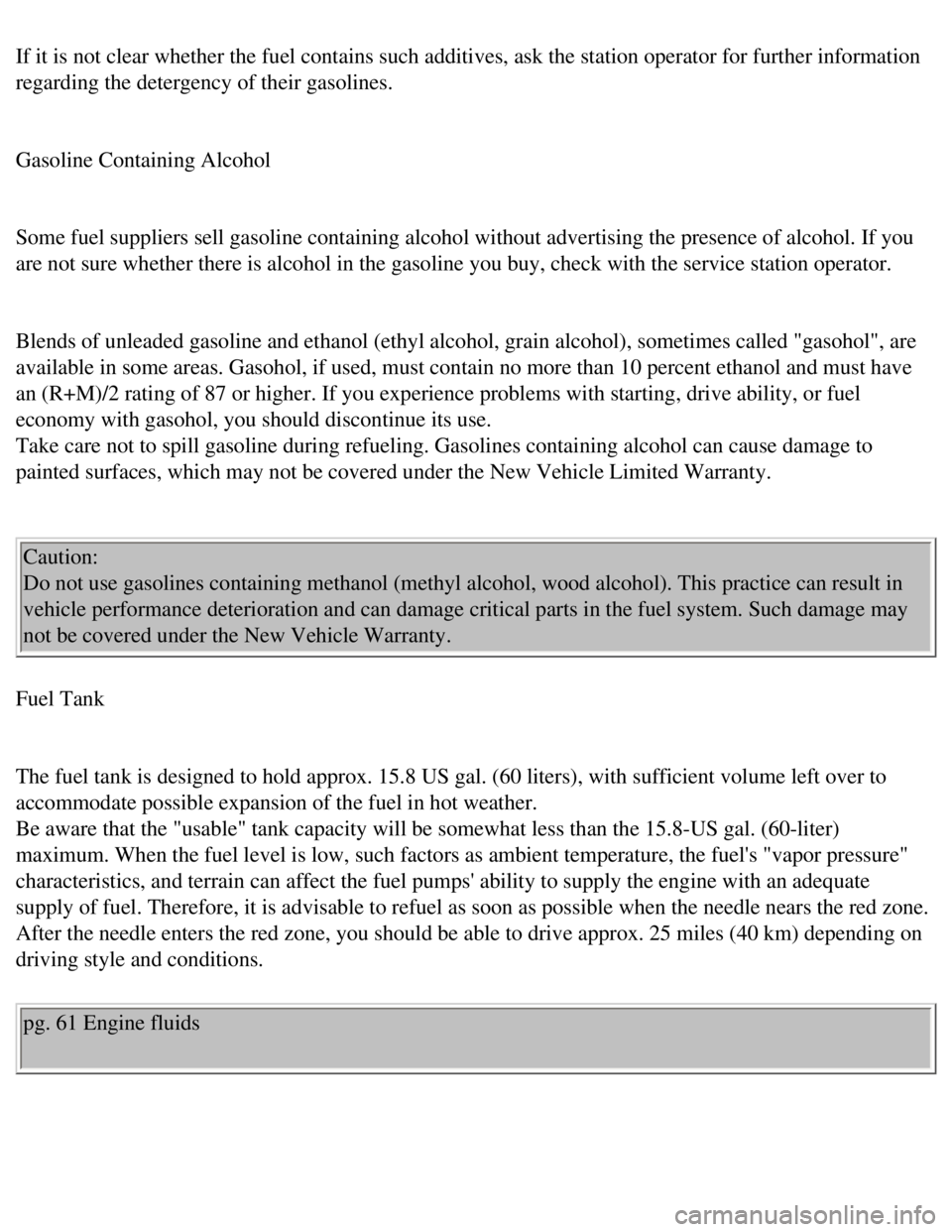
Volvo 1990 240 Model
If it is not clear whether the fuel contains such additives, ask the sta\
tion operator for further information
regarding the detergency of their gasolines.
Gasoline Containing Alcohol
Some fuel suppliers sell gasoline containing alcohol without advertising\
the presence of alcohol. If you
are not sure whether there is alcohol in the gasoline you buy, check wit\
h the service station operator.
Blends of unleaded gasoline and ethanol (ethyl alcohol, grain alcohol)\
, sometimes called "gasohol", are
available in some areas. Gasohol, if used, must contain no more than 10 \
percent ethanol and must have
an (R+M)/2 rating of 87 or higher. If you experience problems with sta\
rting, drive ability, or fuel
economy with gasohol, you should discontinue its use.
Take care not to spill gasoline during refueling. Gasolines containing a\
lcohol can cause damage to
painted surfaces, which may not be covered under the New Vehicle Limited\
Warranty.
Caution:
Do not use gasolines containing methanol (methyl alcohol, wood alcohol)\
. This practice can result in
vehicle performance deterioration and can damage critical parts in the f\
uel system. Such damage may
not be covered under the New Vehicle Warranty.
Fuel Tank
The fuel tank is designed to hold approx. 15.8 US gal. (60 liters), wi\
th sufficient volume left over to
accommodate possible expansion of the fuel in hot weather.
Be aware that the "usable" tank capacity will be somewhat less than the \
15.8-US gal. (60-liter)
maximum. When the fuel level is low, such factors as ambient temperature\
, the fuel's "vapor pressure"
characteristics, and terrain can affect the fuel pumps' ability to suppl\
y the engine with an adequate
supply of fuel. Therefore, it is advisable to refuel as soon as possible\
when the needle nears the red zone.
After the needle enters the red zone, you should be able to drive approx\
. 25 miles (40 km) depending on
driving style and conditions.
pg. 61 Engine fluids
file:///K|/ownersdocs/1990/1990_240/90240_13.htm (3 of 9)12/30/2006 8:\
25:08 AM
Page 80 of 143
Volvo 1990 240 Model
Checking oil level
The oil level should be checked each time the fuel tank is refilled. Be \
sure the oil level is maintained
between the upper and lower marks on the dipstick. Low oil level can cau\
se internal damage to the
engine and overfilling can result in high oil consumption. The distance \
between the dipstick marks
represents approx. 1 quart (1 liter) of oil.
Changing oil filter
Replace the oil filter at every oil change. If the oil filter is changed\
separately, 1/2 US qt = 1/2 liter of oil
should be added.
To add oil or change oil
Add oil of the same kind as already used. See engine oil section.
Note: Allow engine to cool before changing
oil.
Coolant
Maintain fluid level between MAX and MIN marks on expansion tank. Mixtur\
e of 50 percent Volvo
antifreeze type C (blue-green) or similar and 50 percent water should \
be used. See "Coolant" section.
file:///K|/ownersdocs/1990/1990_240/90240_13.htm (4 of 9)12/30/2006 8:\
25:08 AM
Page 82 of 143
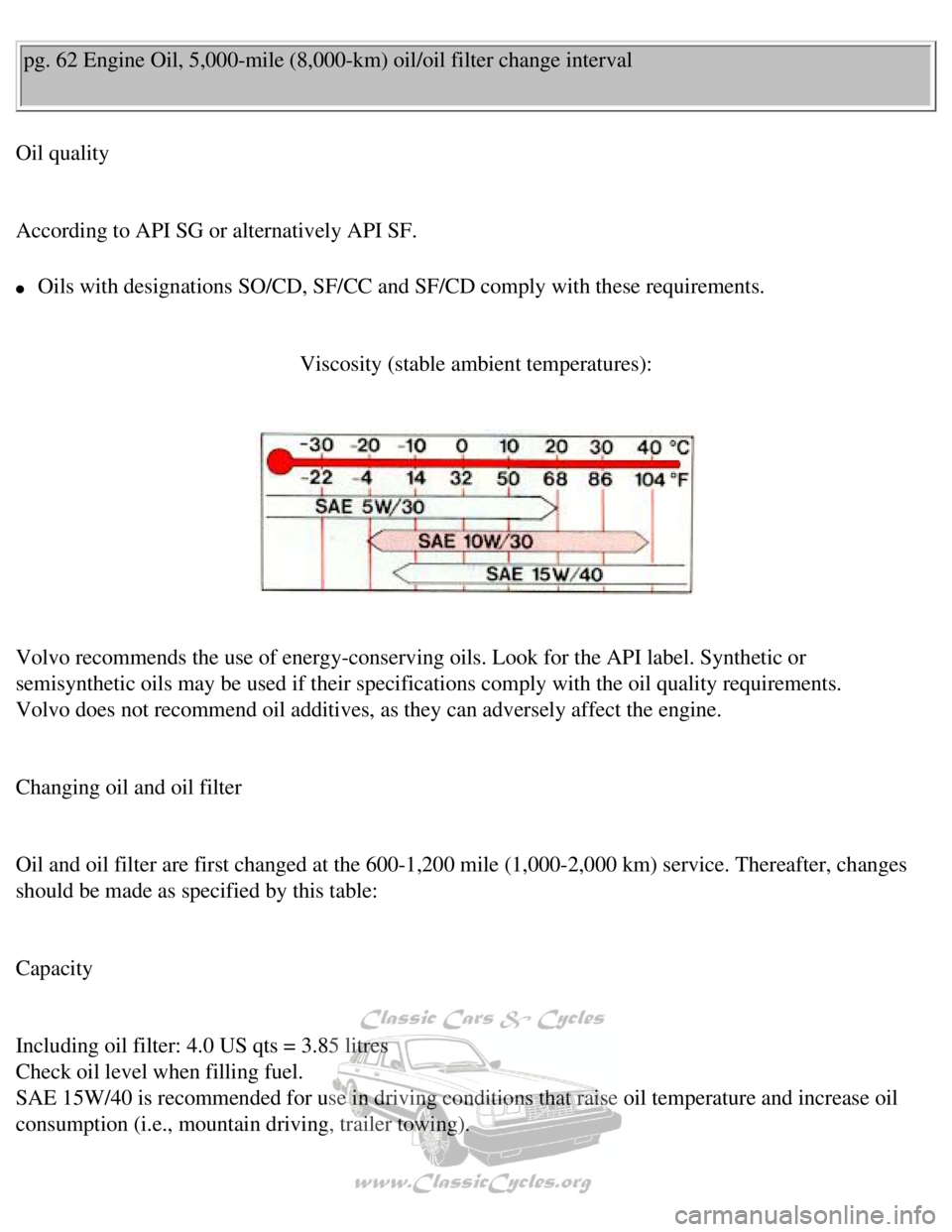
Volvo 1990 240 Model
pg. 62 Engine Oil, 5,000-mile (8,000-km) oil/oil filter change interva\
l
Oil quality
According to API SG or alternatively API SF.
l Oils with designations SO/CD, SF/CC and SF/CD comply with these requirem\
ents.
Viscosity (stable ambient temperatures):
Volvo recommends the use of energy-conserving oils. Look for the API lab\
el. Synthetic or
semisynthetic oils may be used if their specifications comply with the o\
il quality requirements.
Volvo does not recommend oil additives, as they can adversely affect the\
engine.
Changing oil and oil filter
Oil and oil filter are first changed at the 600-1,200 mile (1,000-2,000\
km) service. Thereafter, changes
should be made as specified by this table:
Capacity
Including oil filter: 4.0 US qts = 3.85 litres
Check oil level when filling fuel.
SAE 15W/40 is recommended for use in driving conditions that raise oil t\
emperature and increase oil
consumption (i.e., mountain driving, trailer towing).
file:///K|/ownersdocs/1990/1990_240/90240_13.htm (6 of 9)12/30/2006 8:\
25:08 AM
Page 84 of 143
Volvo 1990 240 Model
Changing coolant
Every two years or 30,000 miles (48,000 km) the cooling system should \
be drained, flushed and refilled.
Remove the expansion tank cap. Open the drain cock on right side of the \
engine block and disconnect
the lower radiator hose.
Fill coolant through the expansion tank.
The heater controls should be fully open when draining and filling.
Add coolant until the level is up to the MAX mark or slightly above.
Start engine and run until hot. Check the cooling system connections for\
tightness. Also re-check the
coolant level. Capacity: 9.9 US qts. = 9.4 liters (manual transmission \
models); 9.7 US qts = 9.2 liters
(automatic transmission models)
Cooling system, hoses and connections
file:///K|/ownersdocs/1990/1990_240/90240_13.htm (8 of 9)12/30/2006 8:\
25:08 AM
Page 85 of 143
Volvo 1990 240 Model
Check all cooling system hoses and connections for defects or deteriorat\
ion of hoses and loose clamps or
fittings.
Drive belts
The belt tension can be checked by depressing the fan belt at a point mi\
dway between the alternator and
fan pulleys as illustrated. It should be possible to press down the belt\
about 1/4" - 3/8" (5-10 mm). This
also applies to other drive belts on the engine.
If drive belts are replaced, recheck belt tension after driving 600 - 1,\
200 miles (1,000 - 2,000 km).
Contents | Top of Page
w
file:///K|/ownersdocs/1990/1990_240/90240_13.htm (9 of 9)12/30/2006 8:\
25:08 AM
Page 86 of 143
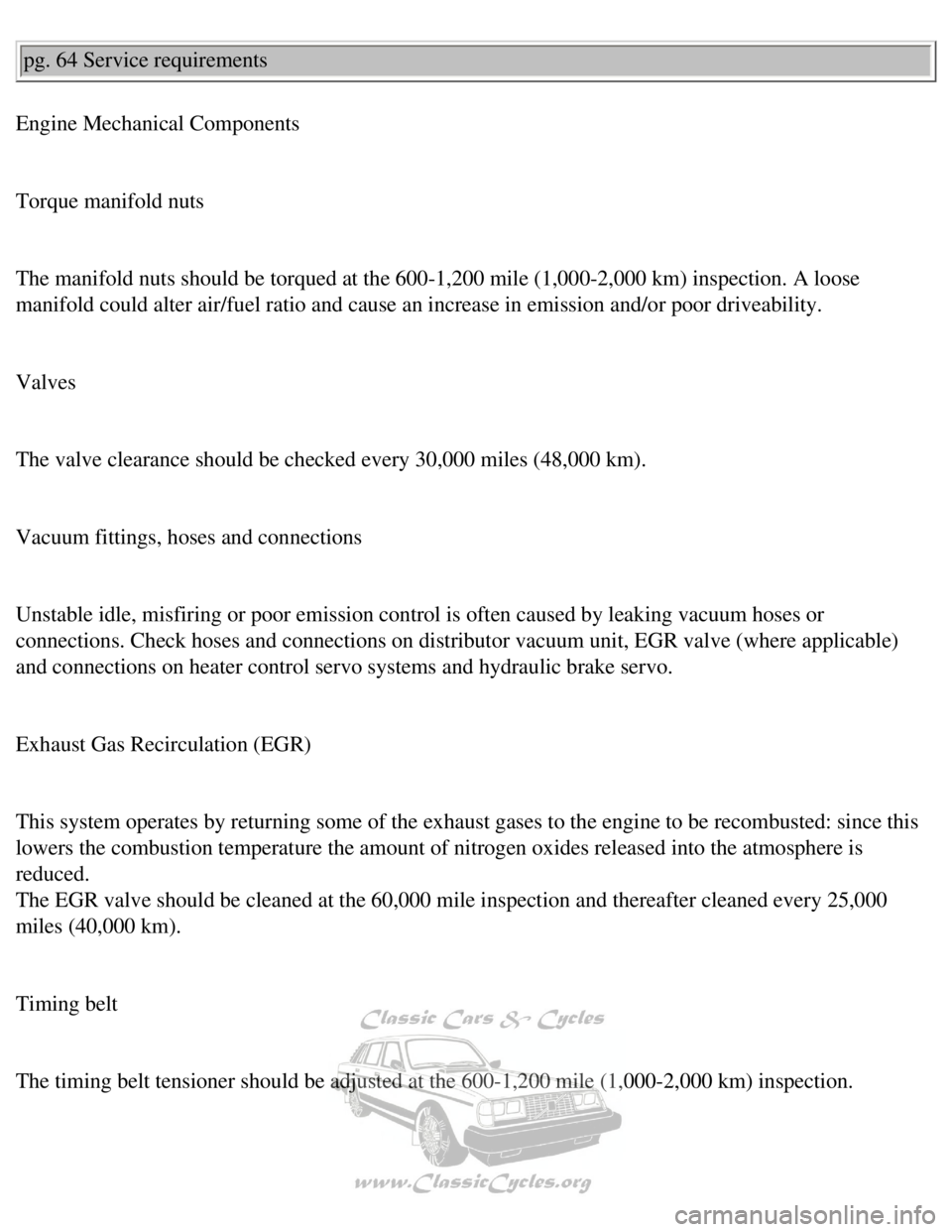
Volvo 1990 240 Model
pg. 64 Service requirements
Engine Mechanical Components
Torque manifold nuts
The manifold nuts should be torqued at the 600-1,200 mile (1,000-2,000 \
km) inspection. A loose
manifold could alter air/fuel ratio and cause an increase in emission an\
d/or poor driveability.
Valves
The valve clearance should be checked every 30,000 miles (48,000 km). \
Vacuum fittings, hoses and connections
Unstable idle, misfiring or poor emission control is often caused by lea\
king vacuum hoses or
connections. Check hoses and connections on distributor vacuum unit, EGR\
valve (where applicable)
and connections on heater control servo systems and hydraulic brake serv\
o.
Exhaust Gas Recirculation (EGR)
This system operates by returning some of the exhaust gases to the engin\
e to be recombusted: since this
lowers the combustion temperature the amount of nitrogen oxides released\
into the atmosphere is
reduced.
The EGR valve should be cleaned at the 60,000 mile inspection and therea\
fter cleaned every 25,000
miles (40,000 km).
Timing belt
The timing belt tensioner should be adjusted at the 600-1,200 mile (1,0\
00-2,000 km) inspection.
file:///K|/ownersdocs/1990/1990_240/90240_14.htm (1 of 7)12/30/2006 8:\
25:08 AM
Page 87 of 143
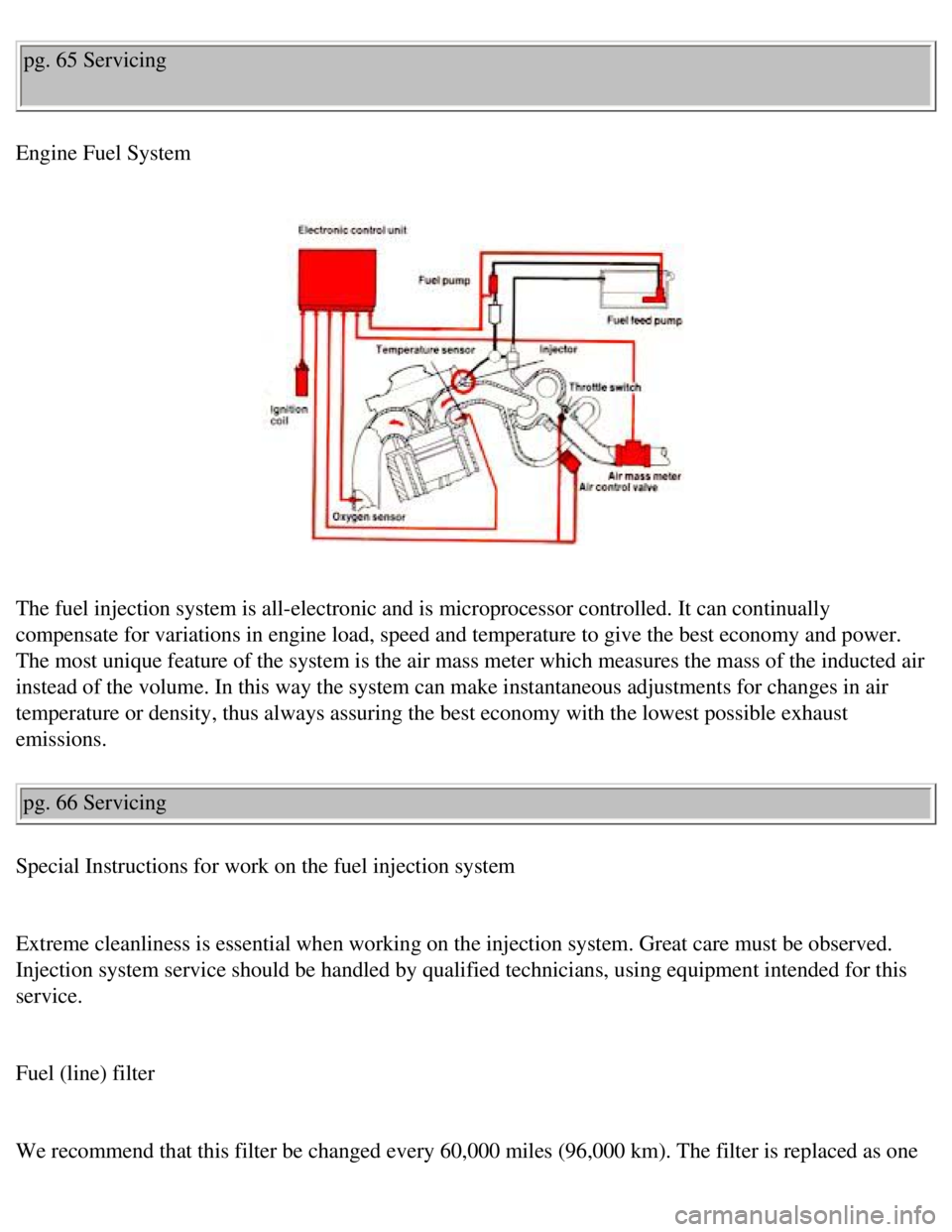
Volvo 1990 240 Model
pg. 65 Servicing
Engine Fuel System
The fuel injection system is all-electronic and is microprocessor contro\
lled. It can continually
compensate for variations in engine load, speed and temperature to give \
the best economy and power.
The most unique feature of the system is the air mass meter which measur\
es the mass of the inducted air
instead of the volume. In this way the system can make instantaneous adj\
ustments for changes in air
temperature or density, thus always assuring the best economy with the l\
owest possible exhaust
emissions. pg. 66 Servicing
Special Instructions for work on the fuel injection system
Extreme cleanliness is essential when working on the injection system. G\
reat care must be observed.
Injection system service should be handled by qualified technicians, usi\
ng equipment intended for this
service.
Fuel (line) filter
We recommend that this filter be changed every 60,000 miles (96,000 km)\
. The filter is replaced as one
file:///K|/ownersdocs/1990/1990_240/90240_14.htm (2 of 7)12/30/2006 8:\
25:08 AM
Page 88 of 143
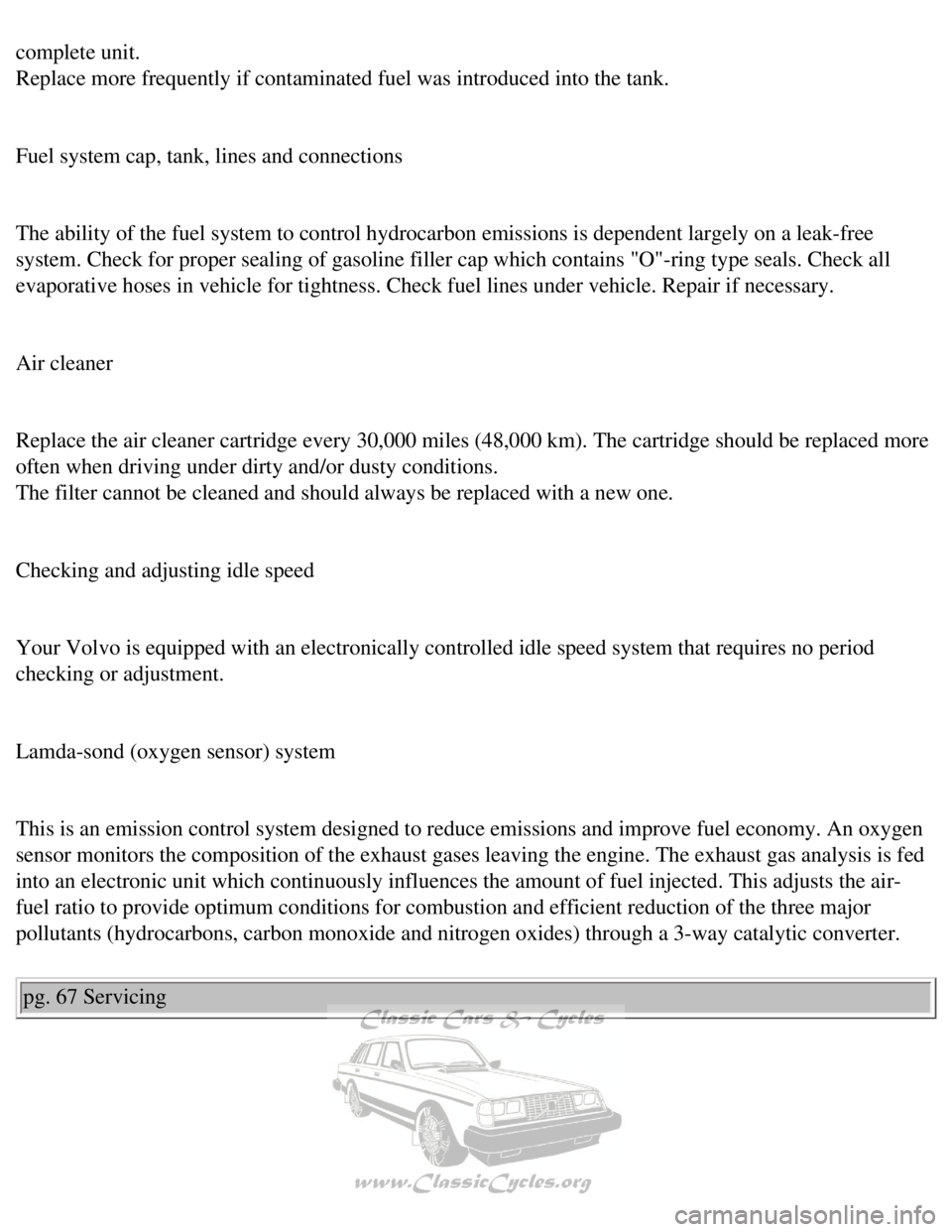
Volvo 1990 240 Model
complete unit.
Replace more frequently if contaminated fuel was introduced into the tan\
k.
Fuel system cap, tank, lines and connections
The ability of the fuel system to control hydrocarbon emissions is depen\
dent largely on a leak-free
system. Check for proper sealing of gasoline filler cap which contains "\
O"-ring type seals. Check all
evaporative hoses in vehicle for tightness. Check fuel lines under vehic\
le. Repair if necessary.
Air cleaner
Replace the air cleaner cartridge every 30,000 miles (48,000 km). The \
cartridge should be replaced more
often when driving under dirty and/or dusty conditions.
The filter cannot be cleaned and should always be replaced with a new on\
e.
Checking and adjusting idle speed
Your Volvo is equipped with an electronically controlled idle speed syst\
em that requires no period
checking or adjustment.
Lamda-sond (oxygen sensor) system
This is an emission control system designed to reduce emissions and impr\
ove fuel economy. An oxygen
sensor monitors the composition of the exhaust gases leaving the engine.\
The exhaust gas analysis is fed
into an electronic unit which continuously influences the amount of fuel\
injected. This adjusts the air-
fuel ratio to provide optimum conditions for combustion and efficient re\
duction of the three major
pollutants (hydrocarbons, carbon monoxide and nitrogen oxides) through\
a 3-way catalytic converter. pg. 67 Servicing
file:///K|/ownersdocs/1990/1990_240/90240_14.htm (3 of 7)12/30/2006 8:\
25:08 AM